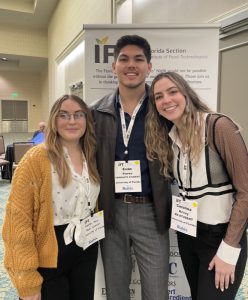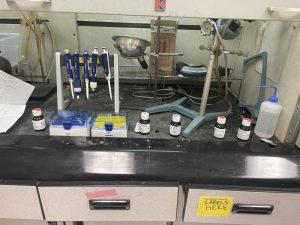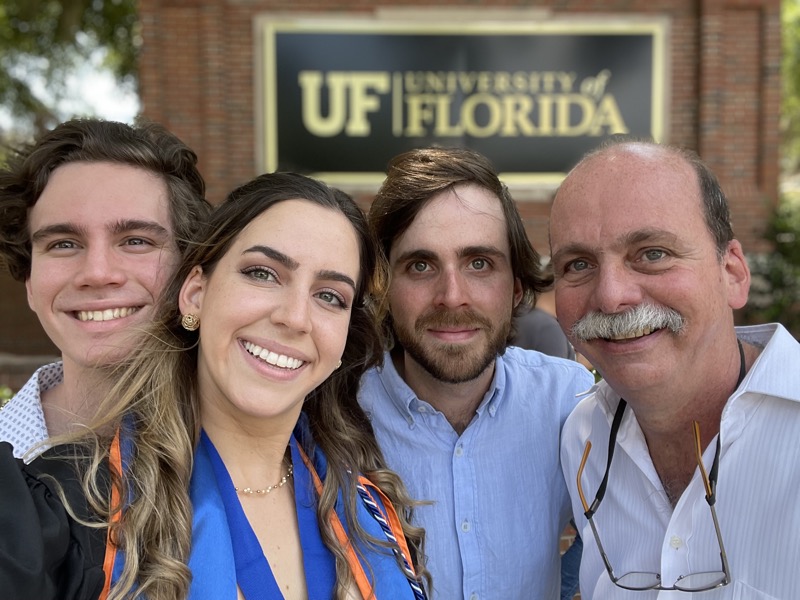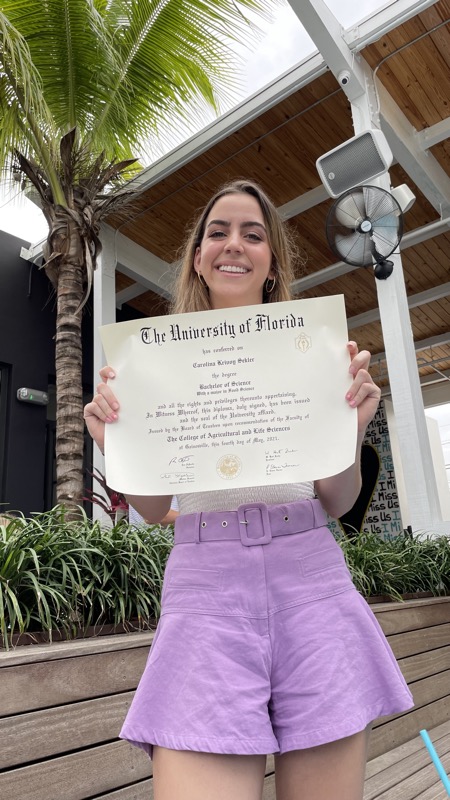 Join us for the next installment of FSHN Research Journeys, which follows the research of graduate students in the Food Science and Human Nutrition program at UF. Today’s guest poster is Carolina Krivoy Sekler, a first-year master’s degree student in food science. She is conducting research under the mentorships of Dr. Charles Sims and Dr. Linda Bartoshuk. Read on to learn about her work with saltiness-enhancing volatiles and how they can improve our health.
Join us for the next installment of FSHN Research Journeys, which follows the research of graduate students in the Food Science and Human Nutrition program at UF. Today’s guest poster is Carolina Krivoy Sekler, a first-year master’s degree student in food science. She is conducting research under the mentorships of Dr. Charles Sims and Dr. Linda Bartoshuk. Read on to learn about her work with saltiness-enhancing volatiles and how they can improve our health.
Carolina:
In the University of Florida taste panel, a panelist places a piece of ham on her tongue and discovers something remarkable. By plugging her nose, she can still taste the saltiness of the ham without detecting the flavor of ham. This “nose bump” technique of assessing foods’ saltiness-enhancing properties has the potential to improve consumer health.
 What Are Saltiness-Enhancing Volatile Compounds?
What Are Saltiness-Enhancing Volatile Compounds?
Taste and flavor are not the same properties. Taste refers to the five basic tastes (sweet, bitter, sour, salty, umami) we perceive in our mouths, while flavor is defined as retronasal olfaction, and it is perceived in our noses. Olfactory receptors located inside the nose capture aroma molecules. Plugging your nose while food is in your mouth is called the nose bump technique. This technique interrupts the detection of aroma—and therefore, flavor—while still allowing you to detect food’s five basic tastes.1
In 2016, Kaipeng (Kevin) Xu’s research for his master’s thesis at UF employed the nose bump technique to assess the separation of saltiness perception and flavor of a variety of foods. When taste panelists’ noses are plugged, the panelists perceive just the basic tastes. When the nose is unplugged immediately after swallowing, panelists detect the flavor of the food item. The panelists can then judge the difference between saltiness with and without flavor. This difference is due to food volatiles.1
A volatile is a substance that easily evaporates at room temperature, and food volatiles provide a flavor fingerprint captured by the olfactory receptors that help humans and animals recognize foods that are safe to eat.2 In his experiments, Kevin found that the volatile-saltiness effect varies between different food samples. Volatile compounds in clam juice, ham, Parmigiano cheese, and peanut butter dark chocolate had the most saltiness-enhancing effects. He also discovered that volatile-enhanced saltiness is not correlated with sodium content. Since high consumption of salt may lead to cardiovascular disease, finding volatiles that cause people to perceive the same saltiness level with a lower sodium content could benefit people’s health.3

The Problem with Too Much Salt
According to Dietary Guidelines for Americans, the recommendation of sodium intake for people 14 years and older is less than 2,300 mg per day, which is equal to about one teaspoon of table salt.4 Excessive consumption of sodium may lead to health problems, including increased blood pressure and increased risk of cardiovascular diseases and strokes. The CDC estimates that 90% of American adults consume too much sodium. Moreover, 29% of U.S. adults have high blood pressure.5 Over time, high blood pressure can damage blood vessel walls. It can also force the heart to work harder while pumping blood, causing part of the heart to thicken and increasing the risk of a heart attack.6
In 2019, high blood pressure was a contributing cause of death for nearly half a million people in the US.6 If the US food industry could find a way to increase the saltiness taste of foods while decreasing sodium content, consumer health could improve. Therefore, I decided to further Kevin’s research by identifying the volatiles with the most saltiness-enhancing effects.

Carolina Discovers the World of Flavors
My strong interest in sensory evaluation, flavor, and research and development (R&D) began after my first internship at SOPROLE, a dairy manufacturer in Santiago, Chile. My R&D experience with IFT and my part-time job in Dr. Charles Sims’ “Sensory Panel Lab” during my undergraduate years reaffirmed what I like the most about food science: sensory, innovation, and development. These fields go hand-in-hand since creating products (R&D) is based on consumer needs (sensory).
Volatiles became my thesis topic thanks to a Zoom meeting I had with Dr. Charles Sims and Dr. Linda Bartoshuk during the second week of my master’s degree program. They explained how researchers and graduate students at UF study flavor volatiles. After this meeting, I decided to resume Kevin Xu’s research.
As a food scientist, I would love to share my knowledge and skills to help the food industry grow and succeed. My research goal is to identify the volatile compounds that have a saltiness-enhancing effect, allowing food companies to decrease the amount of salt in food products. My personal goals are learning how to properly conduct research and write my thesis dissertation. Moreover, I hope to develop new technical skills and strengthen my communication, writing, and adaptability skills.
How Saltiness-Enhancing Volatile Compounds Can Improve Consumer Health

To decrease the sodium content of food products without diminishing flavor and quality has been a challenge for the food industry. Volatile-enhanced-saltiness has the potential to reduce sodium content without losing high-quality flavors in foods such as frozen veggies and soups. Food companies could add saltiness-enhancing volatiles to their products. However, establishing the right concentration of volatiles is challenging since they are present in small concentrations (ppm-parts per million or ppb-parts per billion).
While conducting my research, I will identify volatile compounds that have a saltiness-enhancing effect in selected foods–Parmigiano cheese, tomato, olives–then test them through the nose-bump technique. Then, I will analyze the concentration of the volatiles and evaluate their saltiness-enhancing effects. A challenge I may encounter is that foods often contain hundreds of volatiles, some of which overlap between foods. In addition, volatiles are not the only compounds in foods that may affect saltiness.
Once completed, my research could help the industry by identifying the ideal concentration of volatile-enhanced saltiness to reduce sodium content while maintaining an enjoyable flavor. I also have a hope that my work will inspire other students to pursue food science and flavor chemistry.

Carolina is a Venezuelan Jewish woman. In 2016, she came to the U.S to pursue a better future in education since her country is facing a severe socio-political and economic problem. As an international student, she has worked to develop skills in adaptability and cultural competence. Carolina is a motivated achiever with a positive mindset who craves personal development, knowledge, research practice, and new experiences. Outside of the academic environment, her favorite thing to do is to spend time with her family and friends.

References
- Xu, K. (2016). Assessment of Saltiness Enhancement by Volatiles in Foods (thesis). University of Florida, Gainesville.
- Dini, J. W. (2008, May). Volatile Organic Compounds in Foods and Beverages. Livermore, CA
- National Center for Chronic Disease Prevention and Health Promotion, Division for Heart Disease and Stroke Prevention. (2021, September 27). Sodium. Centers for Disease Control and Prevention. Retrieved October 14, 2021, from https://www.cdc.gov/heartdisease/sodium.htm.
- Center for Food Safety and Applied Nutrition. (2021). Sodium in your diet. U.S. Food and Drug Administration, from https://www.fda.gov/food/nutrition-education-resources-materials/sodium-your-diet#:~:text=Americans%20eat%20on%20average%20about,1%20teaspoon%20of%20table%20salt!
- Centers for Disease Control and Prevention. (2018, February 28). CDC – Sodium Research Reviews: The link between sodium, potassium, and your blood pressure – DHDSP. Centers for Disease Control and Prevention., from https://www.cdc.gov/salt/research_reviews/sodium_potassium_blood_pressure.htm#:~:text=CDC%20estimates%20that%2090%25%20of,related%20to%20lower%20blood%20pressure.
- Centers for Disease Control and Prevention. (2021, May 18). High blood pressure symptoms and causes. Centers for Disease Control and Prevention. Retrieved October 14, 2021, from https://www.cdc.gov/bloodpressure/about.htm.
 6
6

